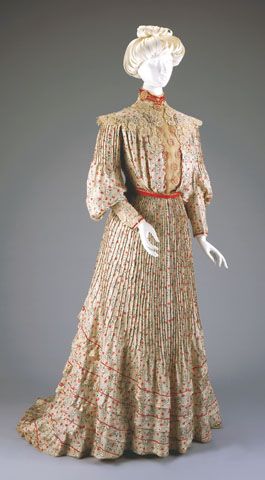Continuing with my examination of Amidala's wardrobe through Episode II ("Attack of the Clones"), I will break down the "packing" dress.
She wears this dress in her apartments while packing her things to undergo the trip back to Naboo. It's a very brief scene at the very beginning of the movie, but still, it became one of her most well-known gowns in Episode II.
The dress consists of a light grey blouse with puff sleeves that are drawn tight by four silver bands at the upper arm. Over the blouse, she wears a high-collared, double-breasted corset of dark blue-grey velvet. The front of the corset is decorated with a finely embroidered brocade panel. The skirt is a darker grey cloth and it's pleated just enough so it ripples.
The design of this dress turns its focus even more westwards, drawing more from European fashion than any of the other designs that I've covered so far. Setting itself apart from the dresses of Episode I, differentiating clearly the "queen" look from the "senator" look.
In this case, though, the historical influence of the design is not so transparent. It pulls from European fashion but doesn't focus on a single country or a single time period. It blends them into the final design quite elegantly.
The main structure of the dress is highly reminiscent of mid-16th-century European fashion (from the 1540s to the 1570s); with the wide skirts, corset and puffed sleeves.
 |
| Isabella de Medici, ca. 1565 |
 |
| Isabella of Valois, Queen of Spain (aprox. 1560) |
The high neck of the corsets seen in these two paintings is very similar to Padme's corset. But the waist of her corset is much lower than the average 16th-century corset, and the sleeves are lighter and more flowing.
And so, while the structure is clearly 16th century Europe, the finishing details are appropriated from the late 19th century and early 20th century art-nouveau Europe.
 |
| Afternoon dress (1901-1902) |
 |
| Wedding dress, London (1902) |
The type of cloth; its weight and consistency are much closer to the early 1900's European fashion. As seen in the pictures above, the shape and flowing cloth of Padme's sleeves are closer to this than to Elizabethan fashion.
Another influence for this look is, undoubtedly, the Czech Art Nouveau painter; Alphonse Mucha. His influence is very noticeable in regard to the jewelry and embroidery of the dress. Let's have a closer look at the silver bands and the brocaded panel.
The use of color and patterns is very common in Mucha's work: blue, gold and silver are key colors in his designs.
In the above pictures, we can see similar embroidered panels: the predominant colors being also blue and gold, and decorated with highly elegant geometrical shapes (the geometrical decorations didn't become fashionable until the late 19th century, so an Elizabethan dress would have never had such decorations).

These two Mucha jewelry pieces (he did more than painting: he also designed furniture and jewelry) are also very similar to the silver bands around her sleeve. They both combine blue and silver with a very "nature" inspired patterns. The use of silver brings the design a more modern look and helps to create that otherworldly feel of the dress.
But, as always with Padme's look, what really gives the design its uniqueness is the hairstyle. For this gown, her hair is done in unique semi-crescent shaped buns on the sides of her head, decorated with a delicate headpiece made of embossed pieces of metal connected by tiny silver chains.
The hairstyle pulls its influence from the Hopi Indians; a native American tribe from the Arizona area.
 |
| Hopi woman |
 |
| Hopi woman |
The Hopi Buns are very characteristic and visually striking. It's only normal that these were appropriated for Padme's design, for it helps to create the futuristic look of the character.
The finishing touch of the hairstyle is the silver headpiece that frames her face. Just as in the other decorations of the dress, the Mucha influence is pretty clear in this piece of jewelry.
The shapes and patterns are very similar to those drawn by Mucha, as is the use of geometrical patterns and base colors.
Both use small and delicate chains to unite the bigger jewelry pieces, using them as a means to frame the face.
The last way in which this design differentiates the "queen" look from the "senator" look, is the makeup: here, as throughout Episode II and III, she always wears a clean and fresh face, removing itself from the iconic "queen" make up.
This is, undoubtedly a gorgeous and elegant design, some may say even too elegant for the scene it's used in. Unfortunately, that is a widespread problem with these movies.
 |
| To see full scale: https://www.pinterest.com/alba0531/a-look-into-star-wars-padmes-dresses/ |
To read A look into Star Wars: Padme's Dresses. Part VI click here.
---------------------------------------------------------------------------------------------------------------
If you enjoyed this article and would like to support the blog,
consider buying me a Coffee? 💛💛
If you want more content like this, subscribe! Or come say hi on Facebook, Tumblr, Twitter, Instagram and help us grow!
DISCLAIMER: I claim no credit for images featured on this site unless noted. Visual content is copyrighted to its respective owners, and inclusion here is under fair use for criticism, comment, and news reporting purposes. If you own the rights to content here and wish it removed, please contact me.












Comments
Post a Comment